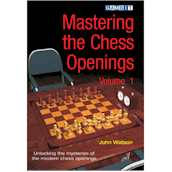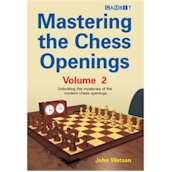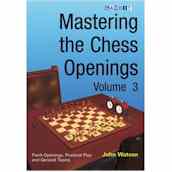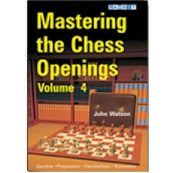 Chess Book Reviews -
Chess Book Reviews -
by the Duke of Brunswick
Watson’s Opening
Mastering the Chess Openings, Volume 3 by John Watson, Gambit Publications 2008, Figurine Algebraic Notation, Paperback, 351pp. $29.95
30 years ago, the American international master John Watson became well known for publishing a four-volume series for Batsford on the English Opening (1 c4). Later he published a very popular repertoire series on the French Defence which, in my opinion, has made the French the second most popular opening against 1 e4 in the UK. At the moment, Watson is coming to the end of a four volume cycle which encompasses all the significant chess openings. His third volume of the Mastering the Chess Openings series covers the English Opening where Black plays 1…c5, 1…e5 or 1…Nf6. A fourth and final volume has been designated to cover 1 Nf3 and moves such as 1 b3, 1 b4, 1 f4, 1 g3 and 1 Nc3. In addition, a few lines with 1 c4, where Black replies 1…c6, 1…b6, 1…g6 and 1…f5 will also be dealt with.
In the introduction Watson writes, “My objective with this work is to provide instruction and analysis ranging from that appropriate for a low-rated developing player with, say, one or two years’ experience, to a long-time player who is familiar with a good deal of theory. That is an ambitious goal, to be sure, and whether this volume fulfils it is a matter I leave for you to judge.”
My first impression after reading the book is that Watson has succeeded admirably. This is not a Modern Chess Openings or Encyclopedia of Chess Openings type book with their exhaustive (and sometimes exhausting) detail . It is also not a standard repertoire book. Its coverage of the English Opening is pretty comprehensive, but you also get explanations of the whys and wherefores of particular opening lines. You need not only subsist on a diet of columns, variations, footnotes and Informator symbols when you buy this book.
Let’s look at how the material is divided:
● General Introduction (2 pages)
● Introduction to the English Opening (3 pages)
● Reversing the Sicilian: 2nd Moves (15 pages)
● Introduction to 2 Nc3: Black Plays Flexibly (35 pages)
● 2…Nf6 and g3 Systems (42 pages)
● Four Knights Variation (33 pages)
● Three Knights and Closed English (35 pages)
● Pure Symmetrical Variation (44 pages)
● Main Lines with 2 Nf3 and d4 (52 pages)
● Asymmetrical Variation (27 pages)
● The Hedgehog Variation (16 pages)
● Mikenas Attack and Nimzo-English (22 pages)
● King’s Indian Variations (10 pages)
● Index of Variations (5 pages)
● Index of Players (2 pages)
We have here a book which is 350 pages in length and rather good value for money. Carsten Hansen wrote two books on 1 c4 e5 and 1 c4 c5 and spent more than 500 pages on those two moves alone. Watson includes some lines with 1…Nf6 and, as already related, his book has explanations and discussions which will appeal to the weaker player.
Watson has chosen to give certain sidelines more attention than is normal in a book of this type. Some may regard this as quirky, but I see it as giving the book its own stamp of individuality. For instance, the line 1 c4 e5 2 Nf3, called by Watson an “Improved Alekhine Sicilian” gets five pages of coverage. This line is, in effect, 1 e4 c5 2 Nf3 Nf6!? (played successfully by Nimzowitsch) in reverse with White taking advantage of the fact that Black has not yet developed his king’s knight.
Watson gives the line: 1 c4 e5 2 Nf3 e4 ( the independent continuation by Black. 2 …Nc6 or 2 … d6 would likely transpose back into main lines) 3 Nd4 Nc6 4 e3 Nxd4 5 ed Qf6! (note that if Black plays the line after 1 e4 c5 2 Nf3 Nf6, this move would not be available for White) and now instead of 6 d5?! Watson recommends the pawn sacrifice 6 Nc3! “giving up a pawn for quick development and a central attack. After 6 … Qxd4 7 Be2 Watson reckons that White is doing fine.
Position after
7 Be2
One line given by Watson is: 7 … Nf6 8 O-O Bb4 9 Nb5!? Qe5 10 d4! exd3 11 Bxd3 O-O 12 Qf3 “intending Bf4 with more than enough play for a pawn.” This is typical of the book. Watson has his own opinions and he is not afraid to give them.
When a line is sharp and its assessment depends on the tactics available to both sides, Watson will delve deeply. Such a line is 1 c4 e5 2 Nc3 d6 3 d4 exd4 4 Qxd4 where White sacrifices development in return for a future positional superiority. Watson spends ten pages on the complexities of this variation alone. But, as Carsten Hansen as pointed out in his column, Watson also spends time explaining the strategies and fundamentals to give the reader a deeper insight. For instance, Watson writes after 1 c4 e5 2 Nc3 d6 3 d4 exd4 4 Qxd4 Nc6 5 Qd2 g6 6 g3 Bg7 7 Bg2 Nf6 8 e4!? 0–0 9 Nge2 Ne5 10 b3 Bh3! 11 0–0 Re8 12 f3! Bxg2 13 Kxg2 a5 14 Bb2 a4! 15 Nd4 c6! (p.49)
Position after 15 … c6

“You could do worse than to study such positions in order to broaden your command of pawn-structures. Notice that the absence of light-squared bishops distinguishes this position for some other English Opening variations, as well as from the Maroczy Bind variation of the Sicilian Defence. Superficially, one might think that the trade of bishops would favour White. In formal terms, after all, it is his bad bishop that is exchanged. The question in such positions, however, is whether Black can summon up the piece activity to counter White’s significant long-term advantage. This often involves attacking light squares that can no longer be guarded by White’s bishop. Here those squares include h3, d3, f3 and often, depending upon specifics, b3 (…axb3), which might be followed by …Nfd7-c5, hitting d3 and b3. Finally, the moves …f5, …b5 and …d5 can be said to attack the most important light squares of all.
“This all sounds very nice, but if Black isn’t able to succeed in creating outposts and/or weaknesses at a fairly early stage, White can slowly drive back Black’s pieces, advance his pawns, and steamroll Black without much effort. The move 15…c6 fulfils the needs of the position described. Given even one extra move here, White could probably consolidate. Thus Black concedes a weakness on d6 in return for activity. He can create threats with his queen from a5 or b6, and simultaneously cause White to worry about …d5, the ultimate line-opening move. Whether this works is a matter of timing and the skill of the respective players.
“Incidentally, some people think that the side with more space should avoid exchanges, but that is poor rule at best. Here White would love to trade a few minor pieces and then utilize his space advantage.”
Apologies for the long quotation as way of illustration. But, it is clear that you will not get comments of this quality and interest in most opening books. Let’s look at another example from later in the book.
After 1 c4 Nf6 2 Nc3 c5 3 g3 d5 4 cd Nxd5 5 Bg2 Nc7 5 Qb3!? Nc6 7 Bxc6+ bc 8 Qa4 Bd7 9 Nf3 f6 10 O-O e5 11 d3 Ne6 12 Ne4 (p. 289)
Watson says, “You may be wondering why White doesn’t attack the c5 pawns with b3 and Ba3, as he does in the Nimzo-Indian (via … Ba6). That’s a reasonable idea and 12 b3 Be7 13 Ba3 isn’t bad. But Black gets to show a new twist, however: 13 …O-O 14 Rfc1 Rb8! 15 Ne4 (15 Qxa7?? Ra8) 15 … Rb5!
Position after 15 … Rb5.
w 
The rook lift which Watson is suggesting here is his own analysis. He says, “Black is threatening … Ra5 winning a piece, so either the bishop has to retreat, to some extent negating the purpose of b3/Ba3, or White plays 16 Qc4 Kh8 when … Qa5 and … Nd4 will equalize, and for the first time the attacking move … f5 is becoming relevant. Black has at any rate leveled the game.”
You can truly learn a lot from comments and suggestions of this caliber, and they are scattered throughout the book. You can see that this book is not just written for low-rated developing players; the complexity of the material increases as Watson delves deeper into particular positions. His aim is to instruct and in doing so, Watson demonstrates typical ideas from both sides, what their plans are and what they should avoid. Watson presents many complete games, but many games are also cut short when there relevance no longer supports the general theme of the opening variation being discussed.
This is the first volume of the series which I have read, but if books one and two (they deal with 1 e4 or 1 d4) are up to the quality of the third, I would be able to recommend their purchase too. They should help you understand the opening phase much better, and probably improve your general knowledge of chess.
In any case, those who play the English Opening should buy this book without any hesitation. It is a modern classic.
For those interested, details of volumes 1 and 2 of this series are given below.
Mastering the Chess Openings – Volume 1 by John Watson, Gambit Publications Ltd 2006, Figurine Algebraic Notation, Paperback, 335pp., $29.95
Mastering the Chess Openings – Volume 2 by John Watson, Gambit Publications Ltd 2007, Figurine Algebraic Notation, Paperback, 319pp., $29.95



Duke of Brunswick

